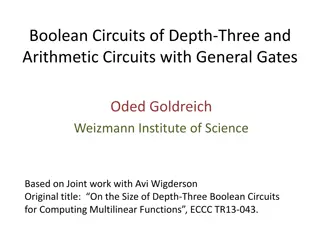
Canonical Depth-Three Boolean Circuits for Multi-Linear Functions and Matrix Rigidity
Explore the study of canonical depth-three Boolean circuits for multi-linear functions, multi-linear circuits, and matrix rigidity with a focus on stronger circuit models and lower bounds. Consider multi-linear functions and depth-three circuits to improve circuit complexity. Discover explicit t-linear functions that require depth-three circuits and delve into canonical Boolean circuits with general gates.
Download Presentation

Please find below an Image/Link to download the presentation.
The content on the website is provided AS IS for your information and personal use only. It may not be sold, licensed, or shared on other websites without obtaining consent from the author. If you encounter any issues during the download, it is possible that the publisher has removed the file from their server.
You are allowed to download the files provided on this website for personal or commercial use, subject to the condition that they are used lawfully. All files are the property of their respective owners.
The content on the website is provided AS IS for your information and personal use only. It may not be sold, licensed, or shared on other websites without obtaining consent from the author.
E N D
Presentation Transcript
Canonical depth-three Boolean circuits for multi-linear functions, multi-linear circuits with general ML gates, and matrix rigidity Oded Goldreich Weizmann Institute of Science Based on joint works with Avi Wigderson and Avishay Tal (see ECCC TR13-043 and TR15-079, resp.) AviFest, Oct 2016
Constant Depth Boolean Circuits Paritynrequires depth d circuits of size exp( (n1/(d-1))), and this is tight. Famous frontier: Stronger circuit models. Another frontier: Stronger lower bounds (i.e., exp( (n))). This will be our focus here. Suggestion 1: Consider multi-linear (e.g., bilinear) functions. Suggestion 2: Focus on depth three. Suggestion 3: Study a restricted class of (canonical) Boolean circuits, which corresponds to (ML) Arithmetic circuits with general (ML) gates. About the latter model: sanity checks, connection to matrix rigidity, an explicit trilinear function that is harder than parity.
Suggestion 1: Consider multilinear functions Recall: Depth d circuits for Paritynhave size exp( (n1/(d-1))). We seek Stronger lower bounds (i.e., exp( (n))). Multi-linear functions : x=(x(1), ,x(t)), x(i) 0,1 n F(x(1), ,x(t)) = (i_1, ,i_t) Txi_1(1) xi_t(t) associated with tensor T [n]t Think of t=2, log n The complexity of computing F is supposed to arise from the complexity of the tensor. Conj (sanity check): For every t>1, there exists a t-linear function that requires depth-three circuits of size exp( (tnt/(t+1))). [holds for t=1 ]
Suggestion 2: Focus on depth three Conj (1stsanity check): For every t>1, there exists a t-linear function that requires depth-three circuits of size exp( (tnt/(t+1))). [holds for t=1] Goal (assuming conj.): For every t>1, present an explicit t-linear function that requires depth-three circuits of size exp( (tnt/(t+1))). [holds for t=1] A 2ndsanity check: Consider a restricted model of (depth-three) circuits, and prove the L.B. in it. t-linear functions x=(x(1), ,x(t)), |x(i)|=n F(x(1), ,x(t)) = (i_1, ,i_t) Txi_1(1) xi_t(t)
Suggestion 3: Canonical Boolean circuits and MultiLinear circuits with general gates Recall (the 2ndsanity check): Consider a restricted model of (depth-three) circuits, and prove the L.B. in it. Motivation: the standard construction of depth-three circuit for n-way Parity. CNF of size exp(sqrt(n)). Parsqrt(n) . . . . . . . . Parsqrt(n) Parsqrt(n) sqrt(n) DNFs of size exp(sqrt(n)). In general, use arbitrary ML gates of bounded arity: A gate of arity is implemented by a CNF/DNF of size exp( ). A depth-two ML circuit with m such gates, yields a (canonical) depth-three Boolean circuit of size m exp( ).
Suggestion 3: Canonical Boolean circuits and MultiLinear circuits with general gates In general, use arbitrary ML gates of bounded arity: A gate of arity is implemented by a CNF/DNF of size exp( ). An ML circuit (of arbitrary depth) with m such gates, yields a (canonical) depth-three Boolean circuit of size exp(m+ ). Goal: For every t>1, present an explicit t-linear function that requires canonical (depth-three) circuits of size exp( (tnt/(t+1))). Def (AN-complexity): The complexity of a (ML) circuit (of arbitrary depth) with arbitrary ML gates equals the maximum between the arity of its gates and the number of gates. E.g., Parity has AN-complexity (sqrt(n)), and we wish to bypass this. Goal (restated): For every t>1, present an explicit t-linear function that require AN-complexity (tnt/(t+1)). (Holds for t=1.)
Are canonical Boolean circuits as powerful as general depth three circuits (wrt computing multilinear function)? Oded: I believe so. Avi: I don t know. In any case, it is begging to prove lower bounds for it (equiv. for AN-complexity): Firstly, because lower bounds on the size of depth-three circuits for ML functions require lower bounds on AN-complexity, and secondly because such lower bounds exist (i.e., hold for non-explicit functions) and are seemingly within reach.
On the AN-complexity of MultiLinear functions Thm1: For every t 1, every t-linear function has AN-complexity O(tnt/(t+1)). Via a circuit of depth 2. Thm2: For every t 1, almost all t-linear functions require AN-complexity (tnt/(t+1)). Thm3: Explicit 3-linear and 4-linear functions of AN-complexity (n0.6) and (n0.666), resp. Def (AN-complexity): The complexity of a circuit with arbitrary ML gates equals the maximum between the arity of its gates and the number of gates. Goal: For every t>1, present an explicit t-linear function that require AN-complexity (tnt/(t+1)).
t-linear functions x=(x(1),,x(t)), |x(i)|=n F(x(1), ,x(t)) = (i_1, ,i_t) Txi_1(1) xi_t(t) Proofs of Thm 1&2 Thm1: For every t 1, every t-linear function has AN-complexity O(tnt/(t+1)). Decompose the tensor T into m=O(tnt/(t+1)) sub-tensors each having side of length nt/(t+1). Compute each tensor by a single gate of arity m, and use a top gate to compute their sum. Thm2: For every t 1, almost all t-linear functions require AN-complexity (tnt/(t+1)). A counting argument: The number of t-ML circuits of AN- complexity m is dominated by (exp(mt))m=mt+1. Def (AN-complexity): The complexity of a circuit with arbitrary ML gates equals the maximum between the arity of its gates and the number of gates.
t-linear functions x=(x(1),,x(t)), |x(i)|=n F(x(1), ,x(t)) = (i_1, ,i_t) Txi_1(1) xi_t(t) Proof of Thm 3 Thm3: Explicit 3-linear and 4-linear functions of AN-complexity (n0.6) and (n0.666), resp. Super Structured Lem3.1: If a bilinear function has AN-complexity m, then the corresponding matrix does not have (ss)-rigidity m3for rank m. Lem3.2: A random Toeplitz matrix M has rigidity (n1.8) for rank n0.6. Use F(x,y) = (i,j) Txiyj= i,jMi,jxiyj Lem3.3: A pseudorandom matrix M has ss-rigidity (n1.999) for rank n0.666. Use F(x,y) = i,jMi,jxiyjfor a bilinear form M. Def (AN-complexity): The complexity of a circuit with arbitrary ML gates equals the maximum between the arity of its gates and the number of gates. Goal: For every t>1, present an explicit t-linear function that require AN-complexity (tnt/(t+1)).
AN-complexity of 2-linear fnc and matrix rigidity Lem3.1: If a bilinear function has AN-complexity m, then the corresponding matrix does not have (super-structured) rigidity m3for rank m. Lem3.2: A random Toeplitz matrix M has rigidity (n1.8) for rank n0.6. Use F(x,y) = (i,j) Txiyj= i,jMi,jxiyj Lem3.3: A pseudorandom matrix M has super-structured rigidity (n1.999) for rank n0.666. Use F(x,y) = i,jMi,jxiyjfor a bilinear form M. Def1: A matrix M does not have rigidity s for rank r if M=S+R such that S has at most s ones (is s-sparse) and R has rank r. Def2: M does not have structured rigidity s for rank r if M=S+R as in Def1 with the ones of S residing in s rectangles of side-length s. Def3: M does not have super-structured rigidity s for rank r if M=S+R as in Def2 such that R is spanned by s-sparse rows and columns. Def: The AN-complexity of a circuit with arbitrary ML gates equals the maximum between the arity of its gates and the number of gates. Note: SS-rigidity is equivalent to AN-complexity t-linear functions x=(x(1), ,x(t)), |x(i)|=n F(x(1), ,x(t)) = (i_1, ,i_t) Txi_1(1) xi_t(t)
The notions of (matrix) rigidity Def1: A matrix M does not have rigidity s for rank r if M=S+R such that S has at most s ones (is s-sparse) and R has rank r. Def2: M does not have structured rigidity s for rank r if M=S+R as in Def1 with the ones of S residing in s rectangles of side-length s. Def3: M does not have super-structured rigidity s for rank r if M=S+R as in Def2 such that R is spanned by s-sparse rows and columns. Def1: non-rigid = sparse + low-rank. Def2: non-structured rigidity = structured-sparse + low-rank, where structure-sparse = sum of few matrices such that in each matrix the 1 s are confined to small rectangles. Def3: non-super-structured rigidity = structured-sparse + low-rank- spanned-by-sparse-row + low-rank-spanned-by-sparse-columns. Def: The AN-complexity of a circuit with arbitrary ML gates equals the maximum between the arity of its gates and the number of gates. Note: Super-Structured-rigidity is equivalent to AN-complexity
Def (AN-complexity): The complexity of a circuit with arbitrary ML gates equals the maximum between the arity of its gates and the number of gates. Open problems Thm3: Explicit 3-linear and 4-linear functions of AN-complexity (n0.6) and (n0.666), resp. Goal: For every t>1, present an explicit t-linear function that require AN-complexity (tnt/(t+1)). Open problem: Explicit 2-linear functions of AN-complexity (n0.51), then (n0.666). Probably w.o. using the rigidity connection Open problem: Explicit O(1)-linear functions of AN-complexity (n0.667). Then, (n0.999). Conj (1stsanity check): For every t>1, there exists a t-linear function that requires depth-three circuits of size exp( (tnt/(t+1))). [holds for t=1]
END Slides available at http://www.wisdom.weizmann.ac.il/~oded/T/avi-kk.pptx Papers available at http://www.wisdom.weizmann.ac.il/~oded/p_kk.html http://www.wisdom.weizmann.ac.il/~oded/p_rigid.html
OLD SLIDES (for 1stpaper) Slides available at http://www.wisdom.weizmann.ac.il/~oded/T/kk.pptx Paper available at http://www.wisdom.weizmann.ac.il/~oded/p_kk.html
Constant Depth Boolean Circuits Paritynrequires depth d circuits of size exp( (n1/(d-1))). Famous frontier: Stronger circuit models. Another frontier: Stronger lower bounds (i.e., exp( (n))). Multi-linear functions : x=(x(1), ,x(t)), x(i) 0,1 n F(x(1), ,x(t)) = (i_1, ,i_t) Txi_1(1) xi_t(t) associated with tensor T [n]t Think of t=2, log n Conj (sanity check): For every t>1, there exists a t-linear function that requires depth-three circuits of size exp( (tnt/(t+1))). [holds for t=1 ]
t-linear functions x=(x(1),,x(t)), |x(i)|=n F(x(1), ,x(t)) = (i_1, ,i_t) Txi_1(1) xi_t(t) The Program* Conj (1stsanity check): For every t>1, there exists a t-linear function that requires depth-three circuits of size exp( (tnt/(t+1))). [holds for t=1] Goal: For every t>1, present an explicit t-linear function that requires depth-three circuits of size exp( (tnt/(t+1))). [holds for t=1] A 2ndsanity check: Consider a restricted model of (depth-three) circuits, and prove the L.B. in it. *) Taking advantage of Avi s absence.
Arithmetic Circuits with General Gates Motivation: Depth-three Boolean Circuits for Paritynare obtained by implementing a sqrt(n)-way sum of sqrt(n)- way sums. In general, depth-three BC are obtained via depth-two AC with general ML-gates. We get depth-three BC for F of size exponential in C2(F) Model: Depth-two (set-)multi-linear circuits with arbitrary (set-)multi-linear gates. Complexity measure (C2) = the (max.) arity of a gate. Recall: We use a fix partition of the variables, and multi-linear means being linear in each variable-block. Depth-three BC obtained this way are restricted in (1) their structure arising from direct composition, and (2) ML gates.
Arithmetic Circuits with General Gates (cont.) Model: Unbounded-depth (set-)multi-linear circuits with arbitrary (set-)multi-linear gates. Complexity measure (C) = max(arity, #gates). PROP: Every ML function F has a depth-three BC of size exp(O(C(F)). PF: guess & verify. THM: There exist bilinear functions F such that C(F)=sqrt(n) but C2(F)= (n2/3). OBS: For every t-linear F, Ct+1(F) 2C(F).
Arith. Circuits with General Gates: Results Model: Unbounded-depth (set-)multi-linear circuits with arbitrary (set-)multi-linear gates. Complexity measure (C) = max(arity, #gates); C2for depth-two. THM 1: There exist bilinear functions F such that C(F)=sqrt(n) but C2(F)= (n2/3). THM 2: For every t-linear function F it holds that C(F) C2(F) = O(tnt/(t+1)). THM 3: Almost all t-linear functions F satisfy C2(F) C(F) = (tnt/(t+1)). Open: An explicit function as in Thm 3; for starters (tn0.51).
Arith. Circuits with General Gates: Results (cont.) Model: Unbounded-depth (set-)multi-linear circuits with arbitrary (set-)multi-linear gates. Complexity measure (C) = max(arity, #gates); C2for depth-two. Open: An explicit function as in Thm 3; for starters (tn0.51). An approach (a candidate): The 3-linear function assoc. with tensor T= (i,j,k): |i-(n/2)|+|j-(n/2)|+|k-(n/2)| n/2 . PROP: The complexity of the above 3-linear function is lower bounded by the maximum complexity of all bilinear functions associated w. Toeplitz matrices. THM: If matrix M has rigidity m3for rank m, then the corresponding bilinear function has complexity (m). Note: A restricted notion of ( structured ) rigidity suffices. Open: Show that Toeplitz matrix w. rigidity n1.51for rank n0.51.
Comments on the proofs Model: Multi-linear circuits with arbitrary multi-linear gates. Complexity measure (C) = max(arity, #gates); C2for depth-two. THM 1: There exist bilinear functions F such that C(F)=sqrt(n) but C2(F)= (n2/3). PF idea: s=sqrt(n), f(x,y)=g(x,L1(y), ,Ls(y)). THM 2: For every t-linear function F it holds that C(F) C2(F) = O(tnt/(t+1)). PF: Covering by m cubes of side m. THM 3: Almost all t-linear functions F satisfy C2(F) C(F) = (tnt/(t+1)). PF: A counting argument. THM 4: If matrix M has rigidity m3for rank m, then the corresponding bilinear function has complexity (m). PF idea: The m linear function yield a rank m matrix, whereas the m quadratic forms (in variables) cover m3entries.
Addl comments on the proof of THM 1 Model: Multi-linear circuits with arbitrary multi-linear gates. Complexity measure (C) = max(arity, #gates); C2for depth-two. THM 1: There exist bilinear functions F such that C(F)=sqrt(n) but C2(F)= (n2/3). PF: For s=sqrt(n), let f(x,y)=g(x,L1(y), ,Ls(y)), where g is generic (over n+s bits), each Licomputes the sum of s variables in y. A generic depth-two ML circuit of complexity m computes f as B(F1(x), ,Fm(x),G1(y), ,Gm(y)) + i [m]Bi(x,y) where the Bi s are quadratic and each function has arity m. Hitting y with a random restriction that leaves one variable alive in each block, we get B(F1(x), ,Fm(x),G 1(y ), ,G m(y )) + i [m]B i(x,y ) where each B I(and G I) depends on O(m/s) variables. Hence, the description length is O(m3/s) ; cf. to ns=n2/s.
Structured Rigidity DEF: Matrix M has (m1,m2,m3)-structured rigidity for rank r if matrix R of rank r the non-zeros of M-R cannot be covered by m1(gen.) m2-by-m3rectangles. Rigidity m1m2m3 implies (m1,m2,m3) structured rigidity for the same rank, but not vice versa. THM 5: There exist matrices of (m,m,m)-structured rigidity for rank m that do not have rigidity 3mn for rank 0 (let alone for rank m). For every m [n0.51,n0.66]. PF: Consider a random matrix with 3mn one-entries. THM 4 : If matrix M has (m,m,m)-structured rigidity for rank m, then the corresponding bilinear function has complexity (m). PF idea: The proof of Thm 4 goes through w.o. any change.
t-linear functions x=(x(1),,x(t)), |x(i)|=n F(x(1), ,x(t)) = (i_1, ,i_t) Txi_1(1) xi_t(t) Summary Long-term/dream goal: For every t>1, present an explicit t-linear function that requires depth-three circuits of size exp( (tnt/(t+1))). [holds for t=1] Conj (1stsanity check): For every t>1, there exists a t-linear function that requires depth-three circuits of size exp( (tnt/(t+1))). [holds for t=1] 2ndsanity check: Prove L.B. for a restricted model of (depth- three) circuits; specifically, Arithm.Ckts with general gates: Current goal: Show that explicit t-linear functions F satisfy C2(F) C(F) = (tnt/(t+1)) or so (i.e. super-sqrt).







